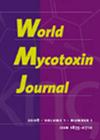Effects of deoxynivalenol on the histomorphology of the liver and kidneys and the expression of MAPKs in weaned rabbits
IF 1.7
4区 医学
Q3 FOOD SCIENCE & TECHNOLOGY
引用次数: 0
Abstract
Deoxynivalenol (DON) is widely present in grain-based feeds and food. It has attracted great attention due to its high contamination rate and strong toxicity. The objective of this study was to analyse the toxic effects of DON on the liver and kidneys of weaned rabbits. 45 weaned male rabbits were allocated into control, low DON dose (0.5 mg/kg body weight), and high DON dose (1.5 mg/kg body weight) groups. Saline or DON was administrated intragastrically in the empty stomach of rabbits every morning. After 24 days of treatment, liver and kidney samples were collected for histological, reverse transcription-quantitative polymerase chain reaction (qRT-PCR), and immunohistochemistry analyses. Haematoxylin eosin staining showed that 0.5 mg/kg BW DON caused mild damage to the liver and kidney morphology, while 1.5 mg/kg body weight DON resulted in hepatic vacuolation and necrosis, as well as tubular stenosis and lesions. Data from qRT-PCR, Western blot, and immunohistochemistry revealed that the mRNA and protein expression and the distribution range of extracellular signal-regulated kinase, p38, and c-Jun NH2-terminal kinase were increased in the liver and kidneys. In conclusion, DON at the tested concentrations damaged the liver and kidneys of rabbits by affecting the expression of key proteins from the mitogen-activated protein kinase signalling pathway. The damage extent was proportional to the amount of DON ingested.脱氧雪腐镰刀菌醇对断奶家兔肝脏和肾脏组织形态学及MAPKs表达的影响
脱氧雪腐镰刀菌烯醇(DON)广泛存在于谷物饲料和食品中。由于其污染率高、毒性强,引起了人们的极大关注。本研究的目的是分析DON对断奶兔肝脏和肾脏的毒性作用。将45只断奶雄兔分为对照组、低DON剂量组(0.5mg/kg体重)和高DON剂量(1.5mg/kg体重)。家兔每天早晨空腹灌胃生理盐水或DON。治疗24天后,收集肝脏和肾脏样本进行组织学、逆转录定量聚合酶链式反应(qRT-PCR)和免疫组织化学分析。苏木精-伊红染色显示,0.5 mg/kg体重的DON对肝脏和肾脏形态造成轻度损伤,而1.5 mg/kg体重的DO导致肝脏空泡化和坏死,以及肾小管狭窄和病变。qRT-PCR、Western印迹和免疫组织化学的数据显示,肝和肾中细胞外信号调节激酶p38和c-Jun NH2末端激酶的mRNA和蛋白表达以及分布范围增加。总之,测试浓度的DON通过影响丝裂原活化蛋白激酶信号通路关键蛋白的表达,损害了兔子的肝脏和肾脏。损伤程度与摄入DON的量成正比。
本文章由计算机程序翻译,如有差异,请以英文原文为准。
求助全文
约1分钟内获得全文
求助全文
来源期刊

World Mycotoxin Journal
MYCOLOGY-
CiteScore
4.60
自引率
5.00%
发文量
25
审稿时长
>12 weeks
期刊介绍:
''World Mycotoxin Journal'' is a peer-reviewed scientific journal with only one specific area of focus: the promotion of the science of mycotoxins. The journal contains original research papers and critical reviews in all areas dealing with mycotoxins, together with opinions, a calendar of forthcoming mycotoxin-related events and book reviews. The journal takes a multidisciplinary approach, and it focuses on a broad spectrum of issues, including toxicology, risk assessment, worldwide occurrence, modelling and prediction of toxin formation, genomics, molecular biology for control of mycotoxigenic fungi, pre-and post-harvest prevention and control, sampling, analytical methodology and quality assurance, food technology, economics and regulatory issues. ''World Mycotoxin Journal'' is intended to serve the needs of researchers and professionals from the scientific community and industry, as well as of policy makers and regulators.
 求助内容:
求助内容: 应助结果提醒方式:
应助结果提醒方式:


